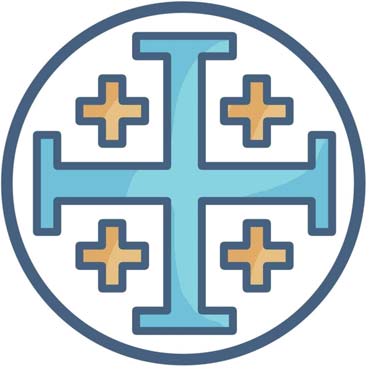Second Sunday of Advent: Jerusalem

On the First Sunday of Advent, the Roman Church gathers around the Crib at Bethlehem, greeted by Mary, as she prepares that Crib for the Divine Birth of Jesus. Symbolically, it represents the preparation of our hearts to receive the Birth of Christ by His coming in grace.
On the Second Sunday of Advent, the Roman Church would have us journey to Jerusalem. (The Roman Stational Church for today is that Roman Church called “The Church of the Holy Cross at Jerusalem”, see the note on pg. 6).
The city of Jerusalem, as a place and as an idea, has several different meanings. It is, of course, the physical place on earth where the Jews had established their holy city. At the time of Our Lord, the Temple in Jerusalem was the only place on earth where sacrifice could be offered to God, hence, even as the Jewish nation dispersed widely, the Jews came back to Jerusalem as pilgrims for their major feasts (e.g., Passover, Pentecost, the Feast of Tabernacles, the Feast of the Dedication/ Hanukkah). It was in Jerusalem that Jesus Christ completed the act of our Redemption by dying a sacrificial death on the Cross. It was also in Jerusalem where the Church began, on the Day of Pentecost, when the Holy Spirit descended upon Our Lady, the Apostles, and the other disciples gathered there in the Upper Room.
Jerusalem is also an image of the Catholic Church, the “New Jerusalem”. Here the Lord dwells in His holy Temple where the one perfect sacrifice of Christ is re-presented on the altars at Mass. Here the grace of Christ in His Sacraments is dispensed. Here the word of God and the words of Christ are proclaimed and preached. When we are in church at Mass We are, in a beautiful sense, in Jerusalem.
The emblem of the Jerusalem Cross, which is associated with the Crusaders’ Latin Kingdom of Jerusalem (1099-1187 A.D.), expresses this New Jerusalem of the Catholic Church.
The Five Crosses signify the Five Chief wounds of Christ on the Cross: two hands, two feet, and the wound which pierced the Sacred Heart. Out of Christ’s wounded side flow the Blood and Water of the life-giving Sacraments: therefore, the Cross of His Heart is the largest in the Jerusalem Cross configuration. The Five Crosses may also be interpreted in reference to the Four Gospel Books of the Bible. Each of the four small crosses represents one of the Four Evangelists, Matthew, Mark, Luke and John. The large cross is Christ Himself. Their accounts draw from and point back to the Living Lord Jesus.
Jerusalem furthermore represents the Eternal Life of Heaven. This is the “new Jerusalem” of St. John’s vision in the Book of the Apocalypse, an eternal Jerusalem: “And I, John, saw the holy city, the new Jerusalem coming down out of heaven from God, prepared as a Bride adorned for her husband. And I heard a great voice from the throne, saying: Behold, the tabernacle of God with men: and He will dwell with them. And they shall be His people: and God Himself with them shall be their God (Apoc. 21:2-3). Finally, we may see “Jerusalem” as a term for the soul in a state of sanctifying grace. That soul—regenerated by Baptism, nurtured by the worthy reception of the Body and Blood of Christ in the Holy Eucharist, walking on the way of the Commandments, seeking to die to the selfish, egotistical self in order to be free to live for God and thereby experience one’s true self—is also Jerusalem.
It would therefore be a good consideration for us in these Advent days to look to making our souls “Jerusalem”, in order to be open to the mysterious ways of grace stirring up in our souls.
+Barbara (Devito) Bowers R.I.P., aged 93 years
On Saturday, November 27th, one of our oldest parishioners Barbara Bowers was laid to rest. The priest-celebrant of her funeral Mass was her grandson, Fr. Robert LeBlanc, who is a parochial vicar at St. Mary’s Church, Brookline. Barbara was a life-long parishioner of Mary Immaculate of Lourdes—baptized and married here. She and her husband Fredson Bowers (d. 2010) raised their six children in her family home. Now that she has laid down the burden of her years, she has been born to eternal life, and hers is the new and eternal Jerusalem of Heaven. Please remember her in the charity of your prayers. She was a lovely, kind, Christian woman and her memory is a benediction.
